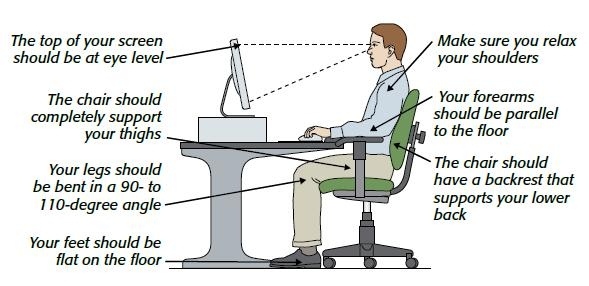Posture
Reasons Why Good Posture is Important
1.) Low back pain is the most common musculoskeletal disorder.
2.) It is estimated that 10-21% of Americans have had neck pain in the past year, with a higher incidence in office and computer workers. (https://ww.ncbi.nlm.nih.gov/pubmed/21665126)
3.) Improper posture and mechanics at the workplace is a leading cause of back and neck pain, which can be prevented with the proper education.
4.) Back and neck pain can limit activities that are enjoyable, which can impact an individual's health and wellness.
5.) Pain or stiffness in your back or neck after prolonged periods of time can possibly be a warning sign of poor posture. Refer to the seated posture checks listed below to help prevent excess stress on your spine and help prevent injury.
6.) The key to proper posture is neutral body positioning. This reduces stress on muscles, tendons, and bones to help prevent musculoskeletal injury.
Posture Checks
Seated Posture Check:
- Feet should be flat on the floor
- Knees and hips should be at the same level
- Pelvis should be in a neutral position (so that you are sitting on your “sit” bones) to allow proper curvature of the spine
- Curvature of the spine should be supported with low back support and your entire back should be against the chair
- Ears should be directly above the shoulders
- Elbows should be bent at 90 degrees
- Shoulders should be relaxed but not rounded
- Wrists and hands should not be bent excessively

Standing Posture Check:
- Feet on the floor, about shoulder width apart
- Placing one foot on a stool or some sort of resting bar can help reduce foot, hip and back discomfort when standing for prolonged periods of time
- Gentle curve in low back, but not extreme
- Gentle bend in the knees (not locked)
- Avoid leaning forward, hunching over, or rounding your shoulders
- Head in line with shoulders (ears should be above shoulders)
- Elbows at 90 degrees
- Wrists and hands should not be bent excessively
Extra Tips:
Put posture check reminders in a place that you frequently see (i.e. computer monitor, phone).
Periodically get up and change positions to help fight fatigue and posture decline (every 30 minutes).

